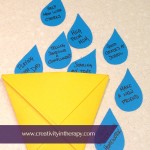
A few months ago I received a copy of Solution Art: A Textbook of Art- and Resource-Oriented Work by Paolo J Knill and Herbert Eberhart (translation by Wayne Sutherland). I’d like to share a bit about the book and some of my takeaways, along with encouragement to you to read it yourself. The book was first published in 2010 in Germany and the English translation was just published in 2023, adding a valuable resource and perspective to the expressive arts therapy literature.
Note – Although my focus on the blog and in my own therapy practice tends to be on visual arts, this book comes from an “expressive arts” lens and offers case examples from other arts, including music and theater.

Below are a few of the concepts and my personal takeaways from the book:
1. A reminder that there is a lot of value in solution/resource focused approaches. One of the things that I enjoyed a lot about this book and the authors’ counseling approach is the focus on helping clients to access their inner resources and shift their focus away from the problem. The authors explain that spending too much time talking about and exploring the problem often keeps the client stuck in a problem-saturated mindset, where they will likely remain helpless and see no way out.
2. Creativity inherently involves drawing on inner resources, seeking solutions, and looking at things in a new way. By being able to engage with their creativity through the expressive arts, clients are then able to turn that creativity toward other aspects of their life in a way that helps them move forward.
“Creativity is defined as a situation in which a person finds a new solution in an old situation by setting aside his or her previous ways of dealing with it or, surprisingly, by reapplying an old solution in a new situation.”
Solution Art
3. Therapists and counselors should view their role as walking alongside the client, facilitating the space and conversation for new insights. Knill and Eberhart caution against the counselor trying to “rescue” the client, interpret the art, or offer the solutions for a situation. Instead, the counselor should be curious, assume that the client has the answers inside themselves, and trust that the process will lead somewhere helpful.
4. Expressive arts in counseling provide an opportunity for stepping away from the problem and getting unstuck. One of the core aspects of the approach in this book is taking time in a session for “decentering” in which the client is asked to engage in a creative, expressive arts-based experiment or activity. Part of the value of this is in helping the client to deliberately step away from and stop focusing on the problem (the “decentering” of the problem). The immersive nature of expressive arts helps with this shift as they engage the client in a sensory-rich experience, invite them to do something different, and require problem-solving, focus, and creativity.
5. The expressive arts are valuable in counseling as an experiential activity. Readers of this blog are probably already mindful of this benefit of expressive arts, but I mention it as a core concept of the book. Engaging in an expressive arts activity allows a client to actually experience something – solving a problem, being successful with limited resources, creating something of beauty, blending multiple ideas and perspectives, trying something new, etc. – instead of just talking about it.
6. Setting intentions in a session provides helpful direction. One of the questions that the authors ask clients is “How will you know at the end of this session that it was worthwhile for you to come here?” As the authors explain, over time this helps the client to practice articulating their needs, experience a sense of successfully moving toward goals, and gives clear direction to the session. Even if you are not working from a solution-focused approach or using the Intermodal Decentering process from this book, I have found a similar question helpful in guiding my art directives for clients – “What do you want to get from the art therapy process today?”
7. A process for “harvesting” insights from the art. The process that the authors lay out for discussing the completed artwork will resonate with many art therapists and expressive arts therapists. However, I still appreciated the refresher on how they guide clients in reflecting on the process and the aesthetics, looking for various possible meanings and themes, then bringing that information back to the original problem and goal in the form of insight or next steps.
I appreciated the way that this book helped me to have some new insights, strategies, approaches, and questions to ask in my art therapy work, as well as a reinforcement of ideas like solution-focused approaches and the value of creativity and play. So, if you are looking for ways to learn more about expressive arts therapy and enrich your work, I recommend reading it.
I’d love to hear your thoughts! Have you read Solution Art and did you find it helpful?
Carolyn Mehlomakulu, LMFT-S, ATR-BC is an art therapist in Austin, Texas who works with children, teens, and families. For more information about telehealth and online therapy, individual therapy, child and teen counseling, and art therapy services, please visit: www.therapywithcarolyn.com. Carolyn is also the author of The Balanced Mind – A Mental Health Journal, a guided journal that combines writing and art prompts to support your mental health.
This blog post contains affiliate links and I earn a small commission for your purchases. This blog is not intended to diagnose or treat any mental health conditions. All directives, interventions, and ideas should be used by qualified individuals within the appropriate bounds of their education, training, and scope of practice. Information presented in this blog does not replace professional training in child and family therapy, art therapy, or play therapy. Art therapy requires a trained art therapist.





Leave a Reply